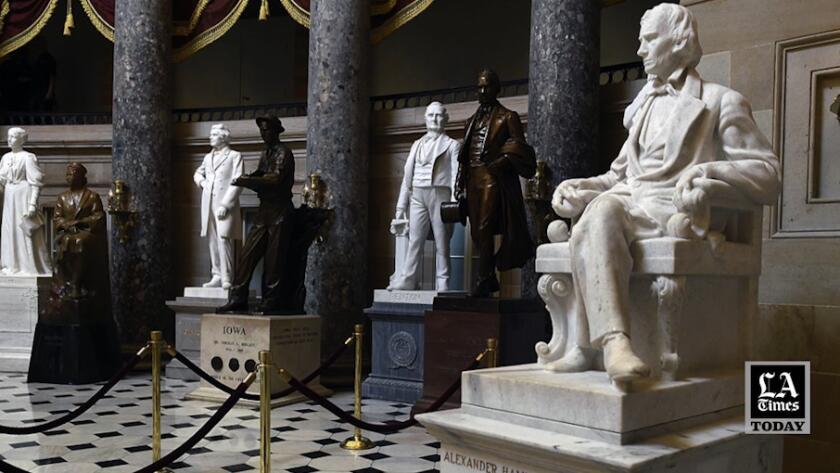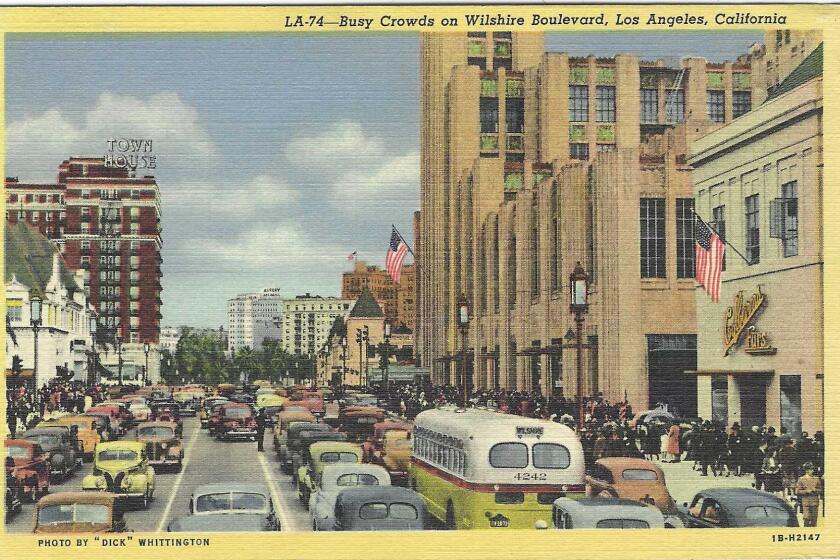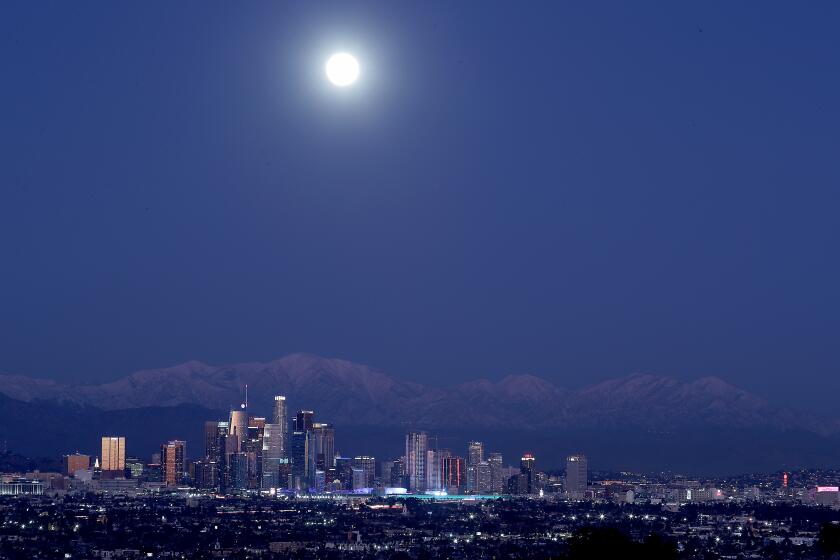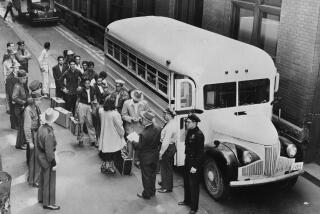If California yanks Junipero Serra’s statue from the U.S. Capitol, who should replace him?
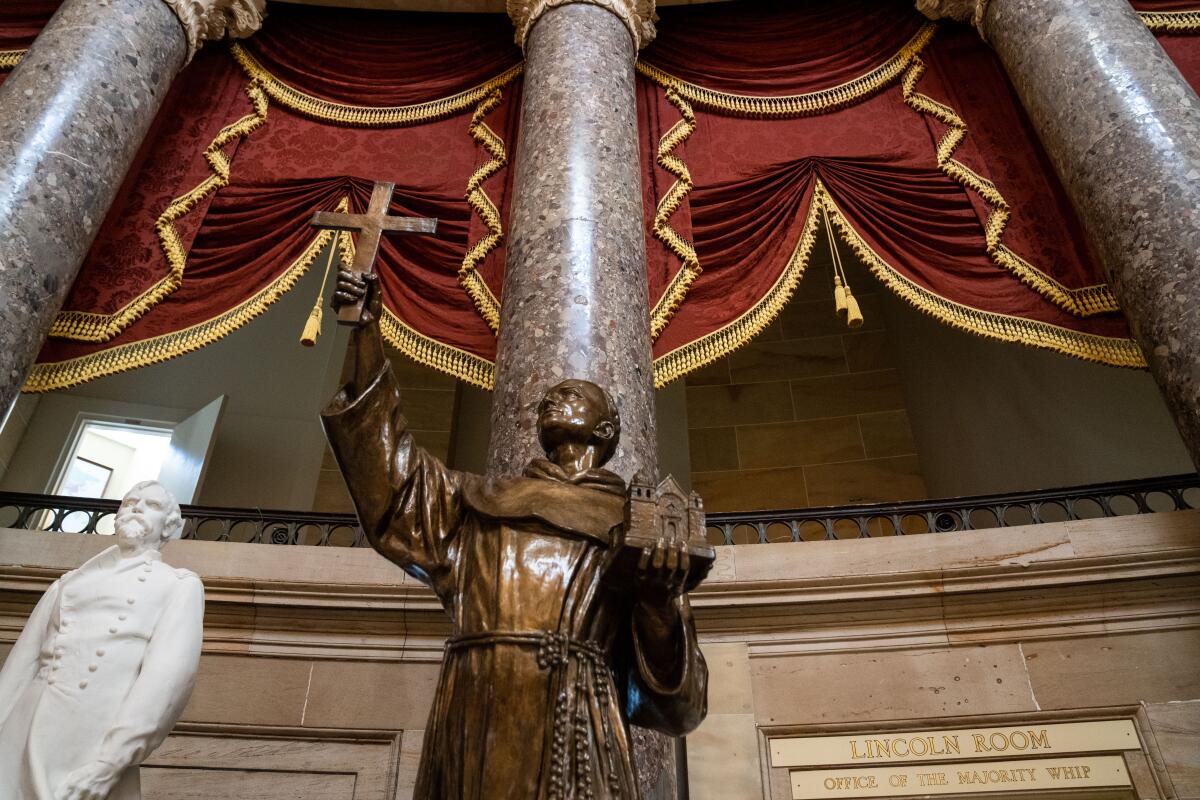
They are the proxies for our two score and 10 states: one hundred dead luminaries rendered in statues of marble or bronze, two from each state, like a Noah’s ark of renown.
They are posed throughout the U.S. Capitol building, standing or sitting for the ages, aloof from the battles that may get some of them evicted from the premises and carted off into obscure storage.
Right now, California is warming up for a fight over who its luminaries should be. This is not trivial; the choice becomes an official metric of who we think we are, and of what we believe California is, or should aspire to be.
These statues are a civic version of fielding an all-star team of our best citizens and heroes. And who does California already have in the game? Ronald Reagan, the Gipper president, and Junipero Serra, the Catholic saint and founder of the California mission system that, in the quest to save their souls, too often cost Native Americans their land, their indigenous practices, and their lives.
Last year, a statue of Serra was pulled down in Los Angeles’ Olvera Street by activists, roped like a rodeo calf and yanked off a pedestal where it had stood since 1932. It was pretty clear then that the Serra statue more than 2,000 miles away in Washington, D.C., might be heading for a fall too.
We’re getting used to our heroic monuments revolving in and out of favor, and to wondering whether our statues should be — or can possibly be — all-time greats? Or just the greats of their time?
Explaining L.A. With Patt Morrison
Los Angeles is a complex place. In this weekly feature, Patt Morrison is explaining how it works, its history and its culture.
Poor Thomas Starr King. In 1931 he and Serra became California’s first two Capitol statues. He too was a man of God, a Universalist minister who came to California in 1860, when it was at the fulcrum of history, viciously riven in its sympathies — Lincoln won the state by only 700-some votes in 1860. If the state and its worldly goods eloped with the secessionists, it could tip the outcome of the Civil War.
King was a wisp of a man, five feet zero, but “though I weigh only 120 pounds,” he promised that “when I’m mad, I weigh a ton.” He spent the four years that remained of his life stumping across California to keep the state in the Union, and declaring for the rights of Chinese and Black Americans. Over the summer, Harvard magazine quoted an unnamed Black historian as saying King was “perhaps the only truly anti-racist white Californian of his time.” His persuasive oratory won over crowds of ten, twenty thousand people.
When he died in 1864 — the year the statuary “hall of fame” began in Washington — California declared three days of mourning. In a state with fewer than half a million people, 20,000 of them went to his funeral. “Keep my memory green,” he had whispered on his deathbed. A peak in Yosemite bears his name. His Capitol statue, given the boot in 2006 by the state Legislature in favor of a bronze Ronald Reagan, now stands in Sacramento. Yet who remembers him now? Should every “eternal statue” have an expiration date?
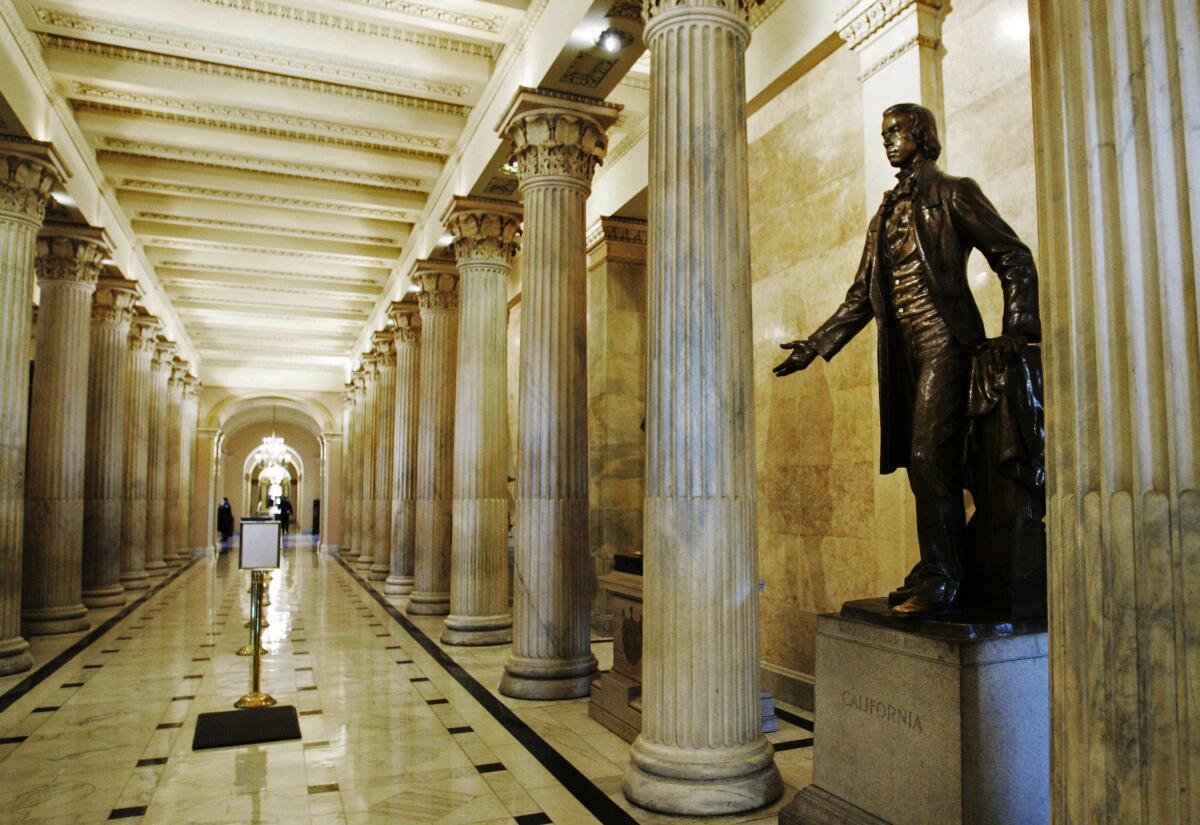
Serra has outlasted King in part because he was canonized in 2015, and what politician wanted to take on that divine mojo? But when Serra’s statue goes — a likelier “when” than “if” — whose will stand on that empty pedestal in D.C.? King’s, again? If not, then whose?
California is home to Nobel Prize winners and billionaire creators and artists of every stripe. We have no shortage of greatness. But a Capitol statue’s subject must meet two criteria: be dead, and have the blessing of the state Legislature and the governor.
Back in 1931, a Van Nuys woman described as a “housewife” and descendant of the lordly Sepulveda family got credit for rousing the state’s women’s clubs and notables to support the Serra and King statues, as The Times reported, “after going over the merits of a score or more historic names.” Tantalizingly, frustratingly, none of those names was listed.
Who were they? How would they rate today? How many august bronze figures don’t have clay feet? Whose character can withstand the scrutiny of the present, and be defensible to the future?
Someone — perhaps a French someone — originated the phrase we know as “No man is a hero to his valet,” meaning no human grandeur can survive close scrutiny. Perhaps no man (or woman) can forever be a hero to history, either.
Watch L.A. Times Today at 7 p.m. on Spectrum News 1 on Channel 1 or live stream on the Spectrum News App. Palos Verdes Peninsula and Orange County viewers can watch on Cox Systems on channel 99.
Yet some men whose demerits you think we’d all agree are more than substantial find favor to this day. In 1931, the year the Serra and King statues took their places in the U.S. Capitol, so too did a statue of a man indicted for treason but never tried: Jefferson Davis, president of the Confederacy. 1931 was 70 years after Davis dramatically resigned his Senate seat when his state seceded from the Union, and also the year Mississippi returned him, in bronze, as one of its two iconic Capitol figures, comparing him favorably to Abraham Lincoln as it did. No modern-day dismay has yet dislodged him.
Since 2000, states have been allowed to change out their statues, which is how Reagan supplanted King. Nine Native Americans’ statues are or will soon be there, including Hawaii’s King Kamehameha I and Oklahoma humorist Will Rogers, born in Cherokee territory. There are more statues of former Confederates than of African Americans.
Angelenos can be spotted a mile away in other locales, waiting for the walk sign while locals jaywalk with abandon. What’s that about? And what happens when people do jaywalk here?
So who should it be, California? Who can stand there for the ages, and also withstand them? Biddy Mason, born into slavery, becoming one of L.A.’s richest and most philanthropic women? Sally Ride, the first American woman in space? Isadora Duncan, an artist and feminist decades ahead of her time? Cesar Chavez, co-founder, with Dolores Huerta, of the groundbreaking United Farm Workers union?
John Muir, who would have been a shoo-in as a seminal environmentalist and naturalist, lost his chance by being, as the Sierra Club he founded put it, “not immune to the racism peddled by many in the early conservation movement.”
Our bench is a deep one. I’ve heard shout-outs for Kobe Bryant, Joe DiMaggio, Steve Jobs, Ray Kroc, Earl Warren and Rabbi Edgar Magnin.
I’ve always favored Toypurina, the Tongva medicine woman who helped to lead an uprising against the San Gabriel Mission, and explained why: “I am angry with the padres, and all of those of the mission, for living here on my native soil, for trespassing upon the land of my forefathers and despoiling our tribal domains.”
If Serra gets the hook, one thing we should not do is put his replacement to a public vote. If you think the 2003 recall election, with its 135 candidates, was electoral lunacy, imagine the chaos attendant on this one.
This single question would drown out any serious, bread-and-butter, dollars-and-cents matters on the ballot. Living candidates for office would have to align themselves with dead candidates for statuary. It’s entirely possible that Californians would vote for Mickey Mouse, or Marilyn Monroe.
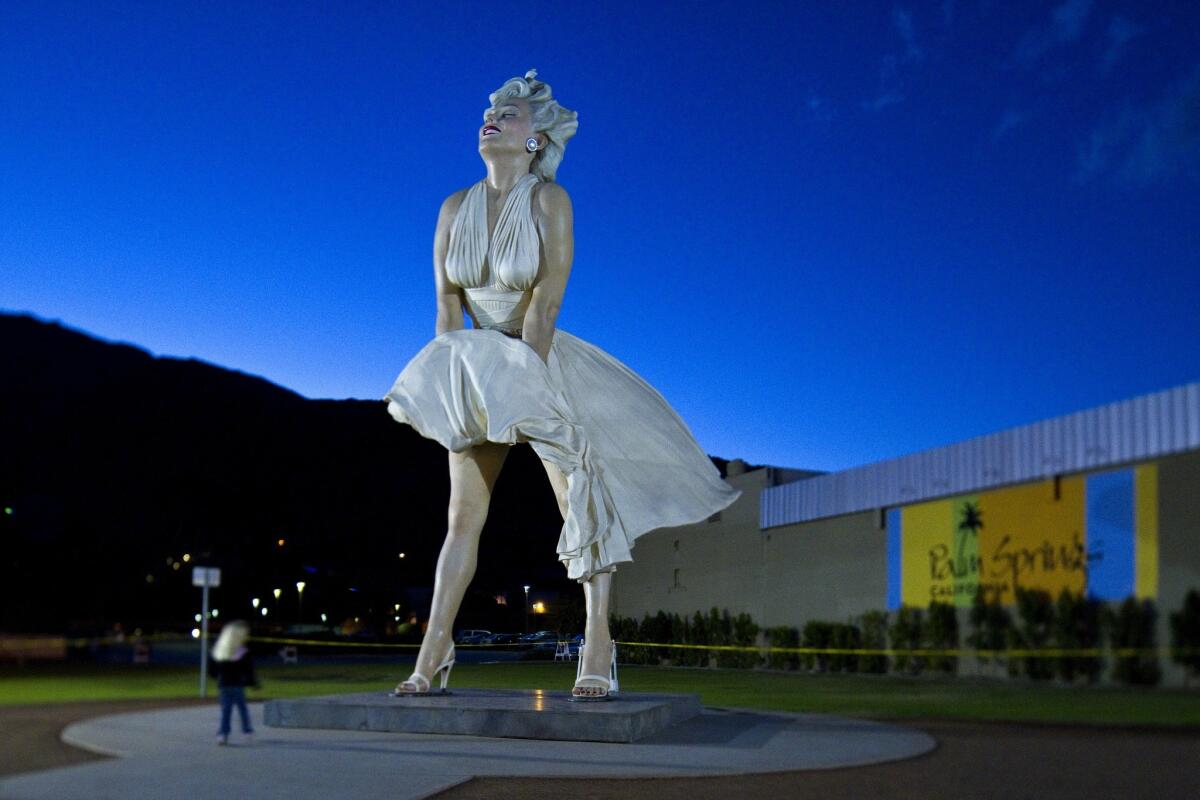
L.A. is a place like no other. You’ve got questions. Patt Morrison probably has answers and can definitely find out.
More to Read
Sign up for Essential California
The most important California stories and recommendations in your inbox every morning.
You may occasionally receive promotional content from the Los Angeles Times.

